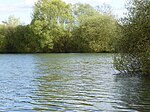St Mary & All Saints' Church, Holcot

St Mary & All Saints' Church is an Anglican Church and the parish church of Holcot. It is a Grade II listed building and stands on the west side of Main Street. There was presumably a church at Holcot by 1086, when the Domesday Book records the presence of a priest there, although it does not mention a church building as such.The main structure of the present building was erected in the 13th and 14th centuries. Restoration took place in 1845 and in 1889. The church now consists of a nave, north and south aisles, chancel and west tower. A detailed description also appears on the Historic England website.The parish registers survive from 1559, the historic registers being deposited at Northamptonshire Record Office.Holcot is part of a united Benefice along with Brixworth. Each parish retains its own church building.
Excerpt from the Wikipedia article St Mary & All Saints' Church, Holcot (License: CC BY-SA 3.0, Authors, Images).St Mary & All Saints' Church, Holcot
Main Street,
Geographical coordinates (GPS) Address Nearby Places Show on map
Geographical coordinates (GPS)
| Latitude | Longitude |
|---|---|
| N 52.32087 ° | E -0.83905 ° |
Address
Main Street
NN6 9TL , Holcot
England, United Kingdom
Open on Google Maps







